Tohatsu MWX50D2 User Manual
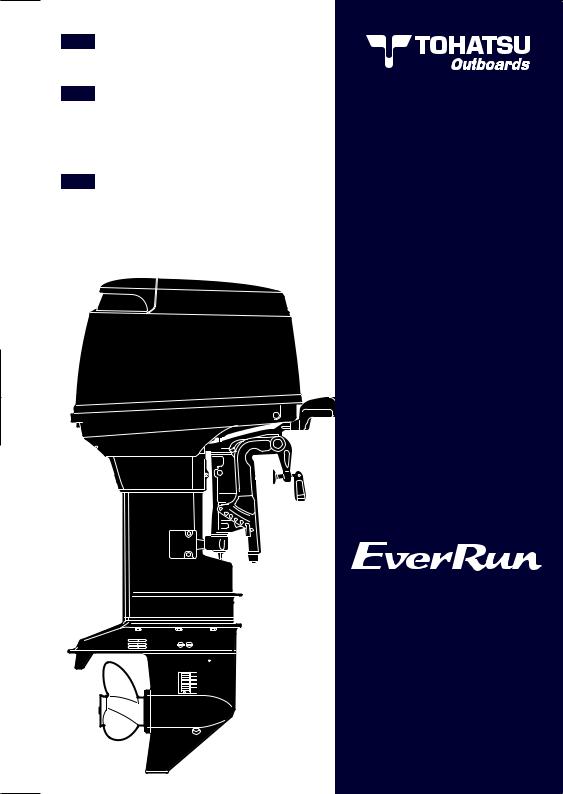
GB
OWNER’S MANUAL
F
MANUEL
DE L’UTILISATEUR
ES
MANUAL
DEL PROPIETARIO
MX 50D2
MWX 50D2
OB No.003-11098-0
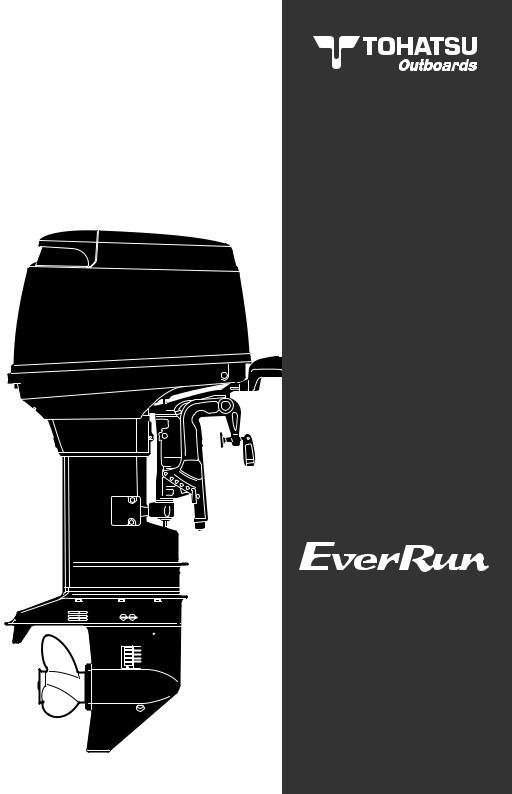
OWNER’S
MANUAL
MX 50D2
MWX 50D2
OB No.003-11098-0

 READ THIS MANUAL BEFORE USING THE OUTBOARD MOTOR. FAILURE TO FOLLOW THE INSTRUCTIONS AND SAFETY PRECAUTIONS IN THIS MANUAL CAN RESULT IN SERIOUS INJURY OR DEATH. KEEP THIS MANUAL IN A SAFE LOCATION FOR FUTURE REFERENCE.
READ THIS MANUAL BEFORE USING THE OUTBOARD MOTOR. FAILURE TO FOLLOW THE INSTRUCTIONS AND SAFETY PRECAUTIONS IN THIS MANUAL CAN RESULT IN SERIOUS INJURY OR DEATH. KEEP THIS MANUAL IN A SAFE LOCATION FOR FUTURE REFERENCE.
Copyright © 2011 Tohatsu Corporation. All rights reserved. No part of this manual may be reproduced or transmitted in any from or by any means without the express written permission of Tohatsu Corporation.
YOUR TOHATSU OUTBOARD MOTOR
OWNER REGISTRATION AND IDENTIFICATION
Upon purchasing this product, be sure that the WARRANTY CARD is correctly and completely filled out and mailed to the addressee noted there on. This WARRANTY CARD identifies you as the legal owner of the product and serves as your warranty registration.
TO THE EXTENT PERMITTED BY APPLICABLE LAW, YOUR OUTBOARD MOTOR WILL NOT BE COVERED BY THE APPLICABLE LIMITED WARRANTY, IF THIS PROCEDURE IS NOT FOLLOWED.
PRE-DELIVERY CHECK
Be sure that the product has been checked by an authorized TOHATSU dealer before you take delivery.
Limited Warranty
Please refer to the TOHATSU outboard motor Limited warranty provided to you with this product, the terms and conditions of which, as amended from time to time, are incorporated by reference into the manual.

Serial Number
In the space below, please record the outboard motor's serial number (indicated both on the bottom cowl and on the cylinder block). The serial number will be needed in ordering spare parts and the event of theft or to quickly identifying the outboard motor type.
Serial Number :
To You, Our Customer
Thank you for selecting a TOHATSU outboard motor. You are now the proud owner of an excellent outboard motor that will service you for many years to come.
This manual should be read in its entirety and the inspection and maintenance procedures described later in this manual should be followed carefully. Should a problem arise with the outboard motor, please follow the troubleshooting procedures listed at the end of this manual. If the problem persists, contact an authorized TOHATSU service shop or dealer.
We hope you will enjoy your outboard motor and wish you good luck in your boating adventures.
TOHATSU CORPORATION
 CONTENTS
CONTENTS
GENERAL SAFETY INFORMATION . . . . . . . . . . . . . . . . . . . . . . . . . . . . . . . . 8 1. SPECIFICATIONS . . . . . . . . . . . . . . . . . . . . . . . . . . . . . . . . . . . . . . . . . . . . . 10 2. NAMES OF PARTS . . . . . . . . . . . . . . . . . . . . . . . . . . . . . . . . . . . . . . . . . . . . 11 3. INSTALLATION . . . . . . . . . . . . . . . . . . . . . . . . . . . . . . . . . . . . . . . . . . . . . . . 12
1. Mounting the outboard motor on boat . . . . . . . . . . . . . . . . . . . . . . . . . . . 12 2. Propeller Selection . . . . . . . . . . . . . . . . . . . . . . . . . . . . . . . . . . . . . . . . . . . 14
4. PRE-OPERATING PREPARATIONS . . . . . . . . . . . . . . . . . . . . . . . . . . . . . . 15
1. Recommended gasoline types . . . . . . . . . . . . . . . . . . . . . . . . . . . . . . . . . 15 2. Recommended engine oil . . . . . . . . . . . . . . . . . . . . . . . . . . . . . . . . . . . . . 17 3. Break-in . . . . . . . . . . . . . . . . . . . . . . . . . . . . . . . . . . . . . . . . . . . . . . . . . . . 19
5. ENGINE OPERATION . . . . . . . . . . . . . . . . . . . . . . . . . . . . . . . . . . . . . . . . . . 20
1. Starting. . . . . . . . . . . . . . . . . . . . . . . . . . . . . . . . . . . . . . . . . . . . . . . . . . . . 20 2. Warming up the engine . . . . . . . . . . . . . . . . . . . . . . . . . . . . . . . . . . . . . . . 23 3. Forward and reverse . . . . . . . . . . . . . . . . . . . . . . . . . . . . . . . . . . . . . . . . . 24 4. Shallow water running . . . . . . . . . . . . . . . . . . . . . . . . . . . . . . . . . . . . . . . . 26 5. Stopping the engine. . . . . . . . . . . . . . . . . . . . . . . . . . . . . . . . . . . . . . . . . . 27 6. Trim angle . . . . . . . . . . . . . . . . . . . . . . . . . . . . . . . . . . . . . . . . . . . . . . . . . 28 7. Mooring with the engine tilted up . . . . . . . . . . . . . . . . . . . . . . . . . . . . . . . 30
6. REMOVING AND CARRYING THE OUTBOARD MOTOR. . . . . . . . . . . . . . 32
1. Removing the outboard motor. . . . . . . . . . . . . . . . . . . . . . . . . . . . . . . . . . 32 2. Carrying the outboard motor . . . . . . . . . . . . . . . . . . . . . . . . . . . . . . . . . . . 32 3. Storing the outboard motor . . . . . . . . . . . . . . . . . . . . . . . . . . . . . . . . . . . . 33
7. TRAILERING . . . . . . . . . . . . . . . . . . . . . . . . . . . . . . . . . . . . . . . . . . . . . . . . . 35 8. ADJUSTMENT . . . . . . . . . . . . . . . . . . . . . . . . . . . . . . . . . . . . . . . . . . . . . . . . 36
1. Trim tab adjustment . . . . . . . . . . . . . . . . . . . . . . . . . . . . . . . . . . . . . . . . . . 36 2. Steering load adjustment . . . . . . . . . . . . . . . . . . . . . . . . . . . . . . . . . . . . . . 37 3. Throttle grip turning load adjustment. . . . . . . . . . . . . . . . . . . . . . . . . . . . . 38
9. INSPECTION AND MAINTENANCE . . . . . . . . . . . . . . . . . . . . . . . . . . . . . . . 39
1. Daily inspection . . . . . . . . . . . . . . . . . . . . . . . . . . . . . . . . . . . . . . . . . . . . . 40 2. Periodic inspection . . . . . . . . . . . . . . . . . . . . . . . . . . . . . . . . . . . . . . . . . . 44 3. Off-season storage . . . . . . . . . . . . . . . . . . . . . . . . . . . . . . . . . . . . . . . . . . 49 4. Pre-season check . . . . . . . . . . . . . . . . . . . . . . . . . . . . . . . . . . . . . . . . . . . 50 5. Checking after striking underwater object . . . . . . . . . . . . . . . . . . . . . . . . . 51 6. If the engine becomes submerged in water. . . . . . . . . . . . . . . . . . . . . . . . 51 7. Precautions in cold weather. . . . . . . . . . . . . . . . . . . . . . . . . . . . . . . . . . . . 52
10. TROUBLESHOOTING . . . . . . . . . . . . . . . . . . . . . . . . . . . . . . . . . . . . . . . . . . 53 11. TOOL KIT AND SPARE PARTS . . . . . . . . . . . . . . . . . . . . . . . . . . . . . . . . . . 55 12. OPTIONAL ACCESSORIES . . . . . . . . . . . . . . . . . . . . . . . . . . . . . . . . . . . . . 56 13. PROPELLER TABLE . . . . . . . . . . . . . . . . . . . . . . . . . . . . . . . . . . . . . . . . . . . 57 14. WIRING DIAGRAM . . . . . . . . . . . . . . . . . . . . . . . . . . . . . . . . . . . . . . . . . . . . 58
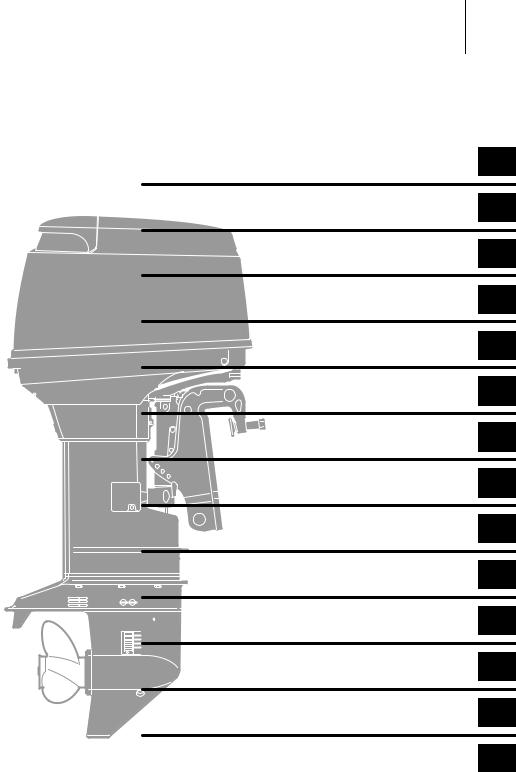
7
 INDEX
INDEX
GENERAL SAFETY INFORMATION
1.SPECIFICATIONS
2.NAMES OF PARTS
3.INSTALLATION
4.PRE-OPERATING PREPARATIONS
5.ENGINE OPERATION
6.REMOVING AND CARRYING THE OUTBOARD MOTOR
7.TRAILERING
 8. ADJUSTMENT
8. ADJUSTMENT
9. INSPECTION AND MAINTENANCE
10.TROUBLESHOOTING
11.TOOL KIT AND SPARE PARTS
12.OPTIONAL ACCESSORIES
13.PROPELLER TABLE
14.WIRING DIAGRAM
1
2
3
4
5
6
7
8
9
10
11
12
13
14

8
 GENERAL SAFETY INFORMATION
GENERAL SAFETY INFORMATION
NOTICE : DANGER/WARNING/CAUTION/Note
Before installing, operating or otherwise handling your outboard motor, be sure to thoroughly read and understand this Owner's Manual and carefully follow all of the instructions. Of particular importance is information preceded by the words "DANGER," "WARNING," "CAUTION," and "Note." Always pay special attention to such information to ensure safe operation of the outboard motor at all times.
 DANGER
DANGER
Failure to observe will result in severe personal injury or death, and possibly property damage.
 WARNING
WARNING
Failure to observe could result in severe personal injury or death, or property damage.
 CAUTION
CAUTION
Failure to observe could result in personal injury or property damage.
Note
This instruction provides special information to facilitate the use or maintenance of the outboard motor or to clarify important points.
EMERGENCY STOP SWITCH
The Emergency Stop Switch will stall the outboard motor when the stop switch tether is pulled off. This stop switch tether can be attached to the operator of the outboard motor to minimize or prevent injuries from the propeller in case the operator falls overboard.
We highly recommend use of the Emergency Stop Switch tether.
 WARNING
WARNING
Accidental activation of the Emergency Stop Switch (such as the tether being pulled out in heavy seas) could cause passengers to lose their balance and even fall overboard, or it could result in loss of power in heavy seas, strong currents, or high winds. Loss of control while mooring is another potential hazard.
To minimize accidental activation of the Emergency Stop Switch, the 500 mm (20 inch.) stop switch tether is coiled and can extended to a full 1,300 mm (51 inch.).

9
SAFE OPERATION OF BOAT
As the operator/driver of the boat, you are responsible for the safety of those aboard and those in other boat around yours, and for following local boating regulations. You should be thoroughly knowledgeable on how to correctly operate the boat, outboard motor, and accessories. To learn about the correct operation and maintenance of the outboard motor, please read through this manual carefully.
It is very difficult for a person standing or floating in the water to take evasive action should he or she see a power boat heading in his /her direction, even at a slow speed. Therefore, when your boat is in the immediate vicinity of people in the water, the outboard motor should be shifted to neutral and shut off.
 WARNING
WARNING
SERIOUS INJURY IS LIKELY IF A PERSON IN THE WATER MAKES CONTACT WITH A MOVING BOAT, GEAR HOUSING, PROPELLER, OR ANY SOLID DEVICE RIGIDLY ATTACHED TO A BOAT OR GEAR HOUSING.
SERVICING, REPLACEMENT PARTS & LUBRICANTS
We recommend that only an authorized service shop perform service or maintenance on this outboard motor. Be sure to use genuine parts, genuine lubricants, or recommended lubricants.
MAINTENANCE
As the owner of this outboard motor, you should be acquainted with correct maintenance procedures. It is the operator's responsibility to perform all safety checks and to ensure that all lubrication and maintenance instructions are complied with for safe operation. Please comply with all instructions concerning lubrication and maintenance. You should take the engine to an authorized dealer or service shop for periodic inspection at the prescribed intervals.
Correct periodic maintenance and proper care of this outboard motor will reduce the chance of problems and limit overall operating expenses.
MOUNTING
Outboard motor mounting must be performed by trained service person(s) using lift or hoist with sufficient capacity.

10 SPECIFICATIONS
 SPECIFICATIONS
SPECIFICATIONS
X50D2MF, WX50D2MF
|
|
Item |
MODEL |
X50D2MF |
|
WX50D2MF |
|
1 |
|||||||
|
Overall Length |
mm (in) |
1,143 (45.0) |
|
1,145 (45.1) |
||
|
|
Overall Width |
mm (in) |
384 (15.1) |
|
384 (15.1) |
|
|
|||||||
|
|
|
S mm (in) |
1,225 (48.2) |
|
|
|
|
|
Overall Height |
L mm (in) |
1,352 (53.2) |
|
1,413 (55.6) |
|
|
|
LL mm (in) |
1,427 (56.1) |
|
|
||
|
|
|
|
||||
|
|
|
UL mm (in) |
1,479 (58.2) |
|
|
|
|
|
|
S mm (in) |
403 (15.9) |
|
|
|
|
|
Transom Height |
L mm (in) |
530 (20.9) |
|
550 (21.7) |
|
|
|
LL mm (in) |
570 (22.5) |
|
|
||
|
|
|
|
||||
|
|
|
UL mm (in) |
657 (25.9) |
|
|
|
|
|
|
S kg (lb) |
72 (159) |
|
|
|
|
|
Weight |
L kg (lb) |
73.5 (162) |
|
79 (174) |
|
|
|
LL kg (lb) |
74 (163) |
|
|
||
|
|
|
|
||||
|
|
|
UL kg (lb) |
75 (165) |
|
|
|
|
|
Output |
kW (Hp) |
|
36.8 (50) |
||
|
|
Max. Operating Range |
rpm |
|
5,150-5,850 |
||
|
|
Number of Cylinders |
|
|
3 |
||
|
|
Piston Displacement |
mL (Cu in) |
|
697 (42.53) |
||
|
|
Bore x Stroke |
mm (in) |
|
68 x 64 (2.68 x 2.52) |
||
|
|
Exhaust System |
|
|
Through hub exhaust |
||
|
|
Engine Lubrication |
|
|
Premixed Fuel |
||
|
|
Fuel mixing Ratio |
|
|
50 : 1 |
||
|
|
Cooling System |
|
|
Forced water cooling |
||
|
|
Starting System |
|
|
Manual |
||
|
|
Ignition System |
|
Flywheel Magneto C.D. Ignition |
|||
|
|
Spark Plugs |
|
|
NGK B8HS-10 |
||
|
|
Trim Position |
|
|
6 |
||
|
|
Engine Oil |
|
Genuine Motor Oil or recommended one (TCW-III) |
|||
|
|
Gear Oil* |
|
approx. 500mL |
|
approx. 700mL |
|
|
|
Fuel Tank Capacity |
L (US gal) |
|
25 (6.6) |
||
|
|
Engine Oil Capacity |
L (US gal) |
|
|
||
|
|
Gear Reduction Ratio |
|
1.85 (13 : 24) |
|
1.92 (12 : 23) |
|
|
|
Fuel |
|
Unleaded regular gasoline pump posted 87 Octane (research octane |
|||
|
|
|
rating of 91) |
|
|
||
|
|
|
|
|
|
||
|
|
|
|
|
|
|
|
* Genuine Gear Oil or API GL5, SAE #80 to #90
Remark: This specifications might change without a previous notice.

NAMES OF PARTS 11
 NAMES OF PARTS
NAMES OF PARTS
X50D2MF, WX50D2MF
1
|
|
|
19 |
20 |
|
|
|
|
|
|
|
|
|
|
18 |
|
|
2 |
|
|
|
2 |
|
|
|
16 |
21 |
||
3 |
|
|
17 |
5 |
|
|
|
|
|
|
|
4 |
|
|
15 |
|
|
5 |
|
|
|
|
|
|
|
|
14 |
|
|
|
|
|
13 |
|
|
|
|
|
22 |
|
|
6 |
|
12 |
|
|
|
7 |
|
|
|
|
|
|
|
|
|
|
|
8 |
|
|
|
|
|
|
|
11 |
|
|
|
9 |
|
10 |
|
|
|
|
|
|
|
|
|
1 |
Tilt Handle |
10 |
Oil Plug (lower) |
19 Starter Handle |
|
2 |
Top Cowl |
11 |
Water Strainer |
20 Stop Switch |
|
3 |
Hook Lever |
12 |
Oil Plug (upper) |
21 Choke Knob |
|
4 |
Water Check Port |
13 |
Clamp Bracket |
22 Anode |
|
5 |
Reverse Lock Lever |
14 |
Thrust Rod |
|
|
6 |
Water Plug |
15 |
Clamp Screw |
|
|
7 |
Anti-ventilation Plate |
16 |
Throttle Grip |
|
|
8 |
Trim Tab |
17 |
Adjust Nut |
|
|
9 |
Propeller |
18 |
Shift Lever |
|
|
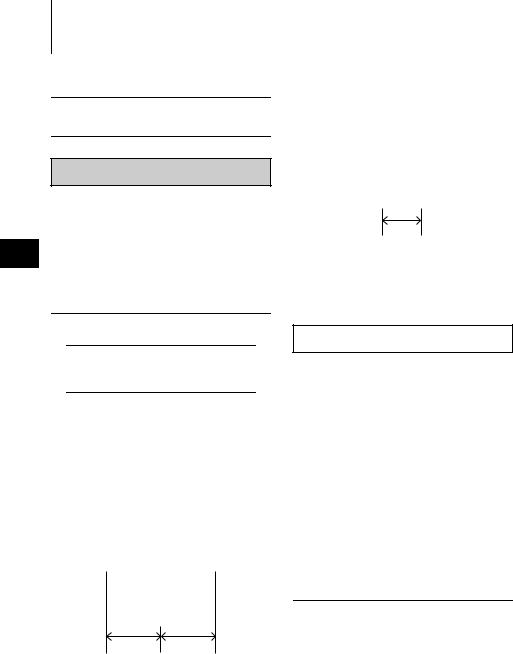
12 INSTALLATION
 INSTALLATION
INSTALLATION
1.Mounting the outboard motor on boat
 WARNING
WARNING
Most boats are rated and certified in terms of their maximum allowable horsepower, as shown on the boat’s certification plate. Do not equip your boat with an outboard
3motor that exceeds this limit. If in doubt, contact your dealer.
Do not operate the outboard motor until it has been securely mounted on the boat in accordance with the instructions below.
Twin-engine Installation
When installing two outboard engines, be sure to keep an interval of approximately 470 - 660 mm (18.5 - 26 in) between the two.
470 - 660 mm
(18.5 - 26.1 in)
Note
Consult your authorized dealer to receive the proper instructions or ask your dealer to mount the motor as necessary.
Installation
Single-engine Installation
Position the outboard engine at the exact center of the stern, and mount it using a cushioning pad or plate.
 CAUTION
CAUTION
Before beginning the running test, check that the boat with maximum capacity loading floats on the water in a proper attitude. Check the position of water surface on the driveshaft housing. If the water surface is near the bottom cowling, in high waves, water may enter the engine cylinders.
Incorrect outboard motor mounting height or existence of underwater object(s), such as hull bottom design, bottom surface conditions or underwater accessories, can cause water spray possibly reaching the engine through an opening of the bottom cowling during cruising. Exposing engine to such conditions for extended periods can lead to severe engine damage.
A A

Transom Height
Install the engine with the Anti-ventilation Plate at a level 10~30mm (0.4~1.2in.) below the bottom of the boat.
10 ~ 30mm (0.4~1.2 in.)
Anti-ventilation Plate
Transom Matching
Be sure that anti ventilation plate of the outboard is below the water surface when running with wide open throttle.
In case the above condition cannot be met due to the shape of your boat, please consult your authorized dealer.
 CAUTION
CAUTION
Overheating may occur if the Anti-ventila- tion Plate is at a level higher than the bottom of the boat, as a result of a lack of cooling water.
If the height difference exceeds 10~30mm (0.4~1.2 in) engine power performance is likely to be reduced as a result of increased water resistance to the gear case assembly.
INSTALLATION 13
Attaching the Clamp Bracket |
|
After positioning the Clamp Bracket, fix it |
|
with clamp screw then drill four holes in |
|
the transom board, matching the holes in |
|
the Clamp Bracket. Secure the engine with |
|
the supplied bolts (M12 x 105mm) and |
|
nuts. Be sure to use the washers. Use the |
|
larger diameter washers inside of the tran- |
|
som board and use the small diameter |
|
washers outside of the clamp bracket. |
3 |
The mounting holes may be drilled before- |
hand by referring to the dimensional drawing.
 WARNING
WARNING
Mounting the outboard motor without following this manual can lead to unsafe conditions such as poor maneuverability, going out of control or fire disaster.
Loose clamp screws and/or mounting bolts can lead to the release or displacement of the outboard motor, possibly resulting in lost of control and/or serious personal injury. Be sure that fasteners are tightened to the specified torque (30 Nm (3.0kgf) 13ft·lb). Check the fasteners for tightness from time to time.
Be sure to use outboard mounting fasteners included in the outboard motor package or their equivalents in terms of size, material, quality and strength.
Tighten fasteners to the specified torque (30 Nm (3.0kgf) 13ft·lb). Test cruise to check if fasteners are tightened securely.
Outboard motor mounting must be performed by trained service person(s) using lift or hoist with sufficient capacity.

14 INSTALLATION
Clamp Bracket
Dimensional Drawing
Manual tilting type
3
|
|
Washer |
|
|
|
(large diameter) |
|
Washer |
|
|
|
(small diameter) |
|
|
|
Bolt |
|
|
Nut |
|
|
|
|
(12mm x length 105mm) |
|
|
|
|
234(9.21”) |
Top of transom |
|
|
|
||
117(4.61”) |
117(4.61”) |
|
|
|
|
|
39(1.54”) |
|
25(0.98”) |
|
64(2.52”) |
|
25(0.98”) |
|
89(3.50”) |
ø13 |
|
|
|
|
204(8.03”) |
|
|
102(4.02”) |
102(4.02”) |
|
|
|
|
|
222(8.74”) |
ø13 |
|
26(1.02”) |
248(9.76”) |
 CAUTION
CAUTION
Mounting bolts should be installed with the bolt head at inside surface of the transom. Mounting bolts installed with the threaded end at the inside surface of the transom can cause personal injury.
2. Propeller Selection
A propeller must be selected so that the engine rpm measured at wide open throttle while cruising is within the max. operating range; 5,150 to 5,850 rpm
For genuine propellers, refer to PROPELLER TABLE (p. 57).

PRE-OPERATING PREPARATIONS 15
 PRE-OPERATING PREPARATIONS
PRE-OPERATING PREPARATIONS
 DANGER
DANGER
Consult an authorized dealer for details on handling of gasoline, if necessary.
Gasoline and its vapors are very flammable and can be explosive.
When carrying a fuel tank containing gasoline:
Close the air vent screw of fuel tank cap, or gasoline vapor will be emitted through the air vent screw, creating a fire hazard.
Do not smoke.
When or before refueling :
Stop the engine, and do not start the engine during refueling.
Do not smoke.
Be careful not to overfill fuel tank. Wipe up any spilled gasoline immediately.
When or before cleaning the gasoline tank :
Dismount fuel tank from the boat.
Place the fuel tank away from every source of ignition, such as sparks or open flames.
Do the work outdoors or in well ventilated area.
Wipe up any spilled gasoline immediately.
After cleaning gasoline tank :
Wipe up any spilled gasoline immediately.
If the fuel tank is disassembled for cleaning, reassemble carefully. Imperfect assembly may cause a fuel leak, possibly leading to fire or explosion.
Dispose of aged or contaminated gasoline in accordance with local regulations.
1. Recommended gasoline types
 CAUTION
CAUTION
Use of low-quality gasoline results in a short engine life as well as starting difficulties and other engine problems.
We recommend use for Fuel stabilizer.
Use of unleaded gasoline
Use a major brand of automotive unleaded gasoline with a minimum posted octane 4 rating of 91RON. Automotive gasoline that contain fuel injector cleaner are preferred
for added internal engine cleanliness. Leaded gasoline is acceptable in areas where unleaded gasoline is not available.
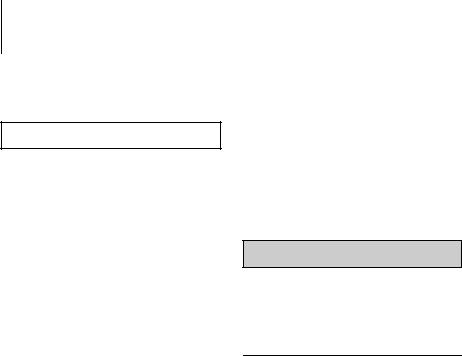
16 PRE-OPERATING PREPARATIONS
Use of alcohol free gasoline
 CAUTION
CAUTION
|
|
Use of gasoline containing alcohol can |
||
|
|
cause engine starting and/or operating dif- |
||
|
|
ficulties, wear of and damages to engine |
||
|
|
parts, and deterioration of chemical parts, |
||
|
|
which may lead to shortening of your out- |
||
|
|
board motor’s life. |
||
|
|
|
|
|
|
|
|
Note |
|
|
|
|
|
|
|
|
|
The adverse effect caused by the alcohol |
|
4 |
|
|
content is more severe with methanol than |
|
|
|
with ethanol. |
||
|
|
|
|
|
TOHATSU recommend the use of gasoline if its ethanol content is less than 10% or methanol content is less than 5%, only in case alcohol free gasoline is not available.
The alcohol component of the gasoline absorbs moisture from the air, which may disturb regular fuel flow in the fuel system, and also accelerate rusting of engine parts.
Mixing of the moisture in the engine oil can also deteriorate the properties of the lubricant.
If the use of gasoline containing alcohol is inevitable, or presence of alcohol is suspected in the gasoline, it is strongly recommended to add a filter that has water separating capability, and check the fuel system for leaks and mechanical parts for corrosion and abnormal wear more frequently.
And, in case any of such abnormality is found, discontinue the use of such gasoline and contact our dealer immediately.
Damages resulting from the use of gasolines that contain alcohol are not covered under the limited warranty.
Fuel tank capacity : 25 liters (6.6 U.S. gal)
Fuel Tank : When using a fixed fuel tank in place of genuine fuel tank, it is recommended to select a one with a structure facilitating interior cleaning.
 WARNING
WARNING
Do not fill the fuel tank over capacity. The rise of gasoline temperature may cause gasoline to expand which, if overfilled, may leak through air vent screw when it is open. Leaking gasoline is a dangerous fire hazard.
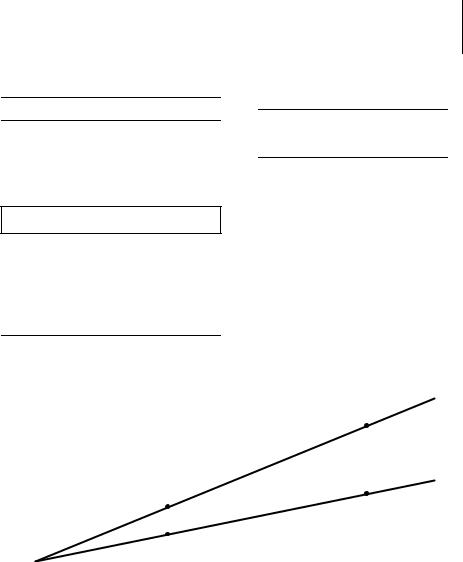
PRE-OPERATING PREPARATIONS 17
Note
2. Recommended engine oil
Use a genuine engine oil or recommended one (TCW3). Refer to your Distributor.
Will not recommend use of other two stroke engine oil.
 CAUTION
CAUTION
Do not mix different brands of oil.
Mixing different brands of oil, or different types of oil even if the brand is the same, may cause gelling, resulting in possible filter screen blockage. This could result in serious engine damage because of impaired lubrication performance.
Use of engine oils that do not meet these requirements will result in reduced engine life, and other engine problems.
Add engine oil into fuel oil tank. The mixing ratio with gasoline is 1 : 50 (one part oil and 50 parts gasoline). Mix well by hand. The mixing ratio during break-in running is 1 : 25.
Mixing Ratio
|
Engine Oil : Gasoline |
|
|
|
|
4 |
|
|
|
|
|
During break-in |
1 : 25 |
|
|
|
|
|
|
After break-in |
1 : 50 |
|
|
|
|
|
|
Oil |
|
|
|
|
|
|
|
|
|
|
Fuel by Oil Mixing (1:25, 1:50) |
|
|
|
|
|
|
|
|
|
|
|||||||||||
1.2L |
|
|
|
|
|
|
|
|
|
|
|
|
|
|
|
|
|
|
|
|
|
|
|
|
|
|
|
|
|
|
|
|
1.1L |
|
|
|
|
|
|
|
|
|
|
|
|
|
|
|
|
|
|
|
|
|
|
|
|
|
|
|
|
|
|
|
|
|
|
|
|
|
|
|
|
|
|
|
|
|
|
|
|
|
|
|
|
|
|
|
|
|
|
|
|
|
|
|
|
|
1.0L |
|
|
|
|
|
|
|
|
|
|
|
|
|
|
|
|
|
|
|
|
|
|
|
|
|
|
(1: 25) |
|
|
|
||
|
|
|
|
|
|
|
|
|
|
|
|
|
|
|
|
|
|
|
|
|
|
|
|
|
|
|
|
|
||||
0.9L |
|
|
|
|
|
|
|
|
|
|
|
|
|
|
|
|
|
|
|
|
|
|
|
|
|
|
||||||
|
|
|
|
|
|
|
|
|
|
|
|
|
|
|
|
|
|
|
|
|
|
|
|
|
||||||||
|
|
|
|
|
|
|
|
|
|
|
|
|
|
|
|
|
|
|
|
|
|
|
|
|
|
|
|
|
|
|
|
|
|
|
|
|
|
|
|
|
|
|
|
|
|
|
|
|
|
|
|
|
|
|
|
|
|
|
|
|
|
|
|
|
|
0.8L |
|
|
|
|
|
|
|
|
|
|
|
|
|
|
|
|
1:25 |
|
|
|
|
|
|
|
|
|
|
|
|
|||
|
|
|
|
|
|
|
|
|
|
|
|
|
|
|
|
|
|
|
|
|
|
|
|
|
|
|
|
|||||
|
|
|
|
|
|
|
|
|
|
|
|
|
|
|
|
|
|
|
|
|
|
|
|
|
|
|
|
|||||
0.7L |
|
|
|
|
|
|
|
|
|
|
|
|
|
|
|
|
|
|
|
|
|
|
|
|
|
|
|
|
|
|
|
|
|
|
|
|
|
|
|
|
|
|
|
|
|
|
|
|
|
|
|
|
|
|
|
|
|
|
|
|
|
|
|
|
|
0.6L |
|
|
|
|
|
|
|
|
|
|
|
|
|
|
|
|
|
|
|
|
|
|
|
|
|
|
|
|
|
|
|
|
|
|
|
|
|
|
|
|
|
|
|
|
|
|
|
|
|
|
|
|
|
|
|
|
|
|
|
|
|
|
|
|
|
|
|
|
|
|
|
|
|
|
|
|
|
|
|
|
|
|
|
|
|
|
|
|
|
|
|
|
|
|
|
|
|
|
0.5L |
|
|
|
|
|
|
|
|
|
|
|
|
|
|
|
|
|
|
|
|
|
|
|
|
|
|
(0.5: 25) |
|
|
|
||
|
|
|
|
|
|
|
|
|
|
|
|
|
|
|
|
|
|
|
|
|
|
|
|
|
|
|
|
|
||||
|
|
|
|
|
|
|
|
|
|
|
|
|
|
|
|
|
|
|
|
|
|
|
|
|
|
|
|
|
||||
0.4L |
|
|
|
|
|
|
|
|
|
|
|
(0.4 : 10) |
|
|
1:50 |
|
|
|
|
|||||||||||||
|
|
|
|
|
|
|
|
|
|
|
|
|
|
|
|
|||||||||||||||||
0.3L |
|
|
|
|
|
|
|
|
|
|
|
|
|
|
|
|
|
|
|
|
|
|
||||||||||
|
|
|
|
|
|
|
|
|
|
|
|
|
|
|
|
|
|
|
|
|
||||||||||||
|
|
|
|
|
|
|
|
|
|
|
|
|
|
|
|
|
|
|
|
|
|
|
|
|
|
|||||||
|
|
|
|
|
|
|
|
|
|
|
|
|
|
|
|
|
|
|
|
|
|
|
|
|
|
|||||||
0.2L |
|
|
|
|
|
|
|
|
|
|
|
(0.2 : 10) |
|
|
|
|
|
|
|
|
|
|
|
|
|
|
|
|
|
|
||
|
|
|
|
|
|
|
|
|
|
|
|
|
|
|
|
|
|
|
|
|
|
|
|
|
|
|
|
|
||||
|
|
|
|
|
|
|
|
|
|
|
|
|
|
|
|
|
|
|
|
|
|
|
|
|
|
|
|
|
||||
0.1L |
|
|
|
|
|
|
|
|
|
|
|
|
|
|
|
|
|
|
|
|
|
|
|
|
|
|
|
|
||||
|
|
|
|
|
|
|
|
|
|
|
|
|
|
|
|
|
|
|
|
|
|
|
|
|
|
|
||||||
|
|
|
|
|
|
|
|
|
|
|
|
|
|
|
|
|
|
|
|
|
|
|
|
|
|
|
|
|
|
|
|
|
0 |
|
|
|
|
|
|
|
|
|
|
|
|
|
|
|
|
|
|
|
|
|
|
|
|
|
|
|
|
|
|
|
|
|
|
|
|
|
|
|
|
|
|
|
|
|
|
|
|
|
|
|
|
|
|
|
|
|
|
|
|
|
|
|
|
|
|
|
2L |
|
10L |
|
|
|
|
|
|
|
|
|
25L |
|
30L |
||||||||||||||||
|
|
|
|
|
|
|
|
|
|
|
|
|
|
|||||||||||||||||||
Gasoline
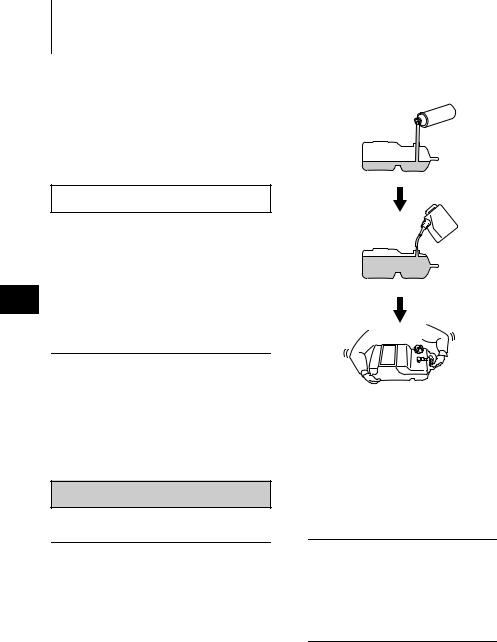
18 PRE-OPERATING PREPARATIONS
Engine oil – gasoline mixing procedure
For quantities of engine oil and gasoline to be pre-mixed, refer to table in Recommended engine oil (p. 17).
 CAUTION
CAUTION
Do not use other than two stroke engine oil with specified grade, or the engine may be damaged.
Do not use fuel prepared in other than specified mixing ratio.
-Lack of engine oil can cause severe 4 engine trouble such as piston seizure.
-Excess of engine oil can shorten spark plug life, and/or cause increase of noxious exhaust.
When portable fuel tank is used for operation of outboard motor(s):
1 Pour engine oil into fuel tank, and then, gasoline.
2 Put cap on the tank, and close tightly.
3 Close air vent plug tightly.
 WARNING
WARNING
Loose cap or air vent plug can cause leak of fuel during shaking the tank.
4Shake the tank to mix engine oil and gasoline well and even.
When fuel tank built in the boat is used for operation of outboard motor(s):
1Prepare separate fuel container for premixing.
2Pour engine oil into fuel container, and then, gasoline.
3Put cap on the container, and close tightly.
4Shake the container to mix engine oil and gasoline well and even.
5 Pour the mixture into fuel tank.
Notes
It is recommended to pre-mix by using separate fuel container. Attempting to pre-mix in the fuel tank built-in the boat can make the mixture uneven.
If built-in fuel tank is used for mixing, pour engine oil into the tank little by little while putting gasoline into the tank.
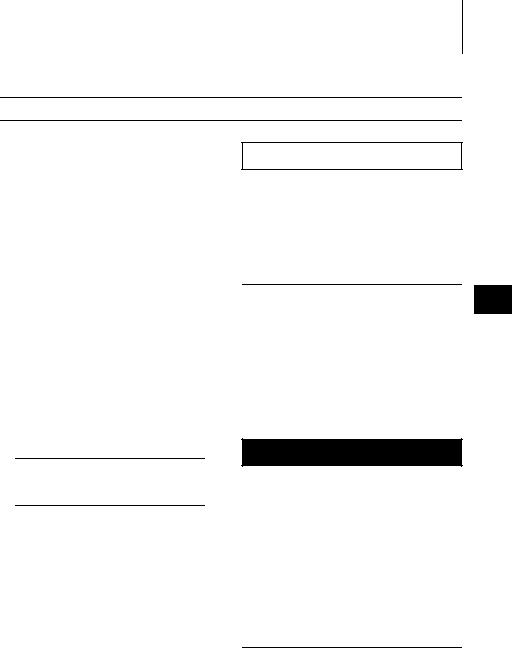
PRE-OPERATING PREPARATIONS 19
3. Break-in
Your new outboard motor and lower unit require break-in for the moving components according to the conditions described in the following time table.
 CAUTION
CAUTION
Operating the outboard motor without break-in can shorten service life of the product.
If any abnormality is experienced during the break-in:
Discontinue the operation immediately.
Have the dealer check the product and take proper action(s) if necessary.
4
|
1-10min |
10min-2hrs |
2-3hrs |
3-10hrs |
After 10hrs |
|
Throttle |
Idle |
Less than 1/2 |
Less than 3/4 |
3/4 throttle |
Full throttle |
|
Position |
throttle |
throttle |
available |
|||
|
|
|||||
|
|
|
|
Approx. |
|
|
|
|
Approx. |
Full throttle run |
4,000 rpm. |
|
|
Speed |
|
allowed for 1 min |
Full throttle run |
|
||
|
3,000 rpm max |
|
||||
|
|
every 10 min |
allowed for 2 min |
|
||
|
|
|
|
|||
|
|
|
|
every 10 min |
|
|
|
|
|
|
|
|
Note
Proper break-in allows outboard motor to deliver it full performance for longer service life.
Fuel mix ratio for break-in
Gasoline 25: Genuine Engine Oil 1
25:1 when using genuine engine oil or the recommended one (TCW3).
 DANGER
DANGER
Do not operate the outboard motor in closed area or area with no forced ventilation.
Exhaust gas emitted by this outboard motor contains carbon monoxide that will cause death if inhaled continuously. Inhaling the gas initially causes symptoms such as feeling of sickness, drowsiness and headache.
During operation of the outboard motor :
Keep peripheral area well ventilated.
Always attempt to stay on the windward side of emission.

20 ENGINE OPERATION
 ENGINE OPERATION
ENGINE OPERATION
1. Starting
Preparations
1 Loosen the air vent screw on the tank cap.
 WARNING
WARNING
In case engine starts in gear, do not start cruising. Stop engine immediately and consult an authorized dealer.
Note
The engine will not start unless the switch lock has been properly connected into the emergency stop switch.
 WARNING
WARNING
5Do not operate the engine with gear case out of water.
Severe personal injury, or engine damage will result.
 CAUTION
CAUTION
Never fill up portable fuel tanks on board to avoid fire or explosion resulting from spilled gasoline. If gasoline is ever spilled on board, wipe it up thoroughly. Fuel tanks must always be filled up on land.
2Connect the fuel connector to the engine.
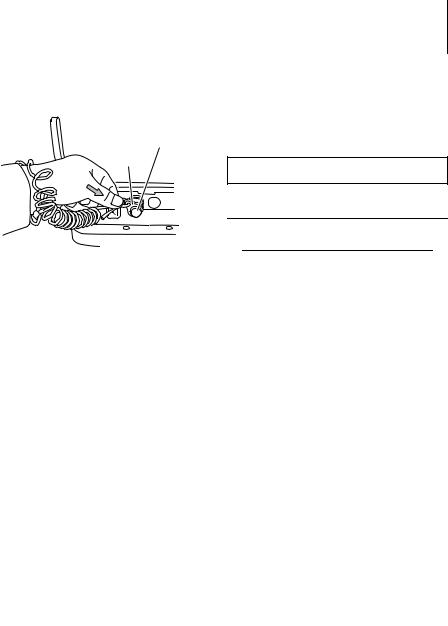
3 Install a lock in the stop switch.
Stop switch
Lock
4Feed fuel to the carburetor by squeezing the primer bulb until firm.
Engine side
Fuel tank side
ENGINE OPERATION 21
Starting
F type
1 Set the shift lever to Neutral
 CAUTION
CAUTION
If the engine starts in gear, do not use it. Contact an authorized dealer.
Note
Start-in-gear protection prevents engine from starting at other than neutral shift. Ingear starting of engine will move the boat immediately, potentially leading to falling down or causing passenger(s) to be thrown overboard due to inertial force.
|
|
|
5 |
N |
|
|
|
R |
F |
|
|
2Turn the throttle grip so that the indicator line meets the "START" mark.
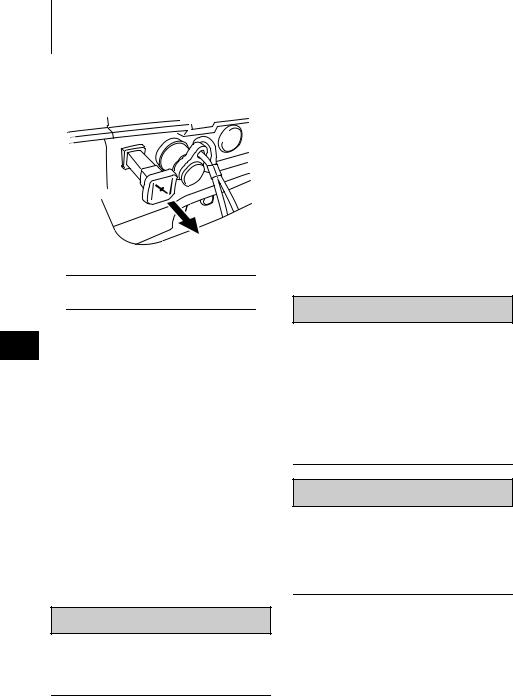
22 ENGINE OPERATION
3 Pull the choke knob fully.
Note
Operation of the choke knob is not required if the engine is warm.
4 Pull the starter rope slowly until resis-
5tance is met.
Give it a sharp tug to start the engine.
5Turn the handle grip to its original position gradually once the engine has started.
6 Push back the choke knob slowly.
7Carefully turn the throttle grip to “SLOW”.
 WARNING
WARNING
Do not operate the engine with gear case out of water.
Severe personal injury, or engine damage will result.
Manual Rope Start - - - in case of trouble with the Recoil Starter
Wind the starter rope around the flywheel a few turns. Give it a sharp tug to start the engine. Use a socket wrench or similar to get a firm grip on the end of the rope.
 WARNING
WARNING
Be careful that your clothes or other items do not get caught in the rotating engine parts.
To prevent accident and injury, do not reattach the recoil starter after the engine has been started using the emergency starter rope. Be sure to put the top cowl back on.
Immediately contact an authorized dealer when reaching shore.
 WARNING
WARNING
Be sure that no bystander(s) is within 2 meters from back of starting operator.
Do not operate the outboard motor with top cowl removed from the power unit, or contacting turning flywheel which can lead to serious personal injury.

ENGINE OPERATION 23
2. Warming up the engine
Before driving the boat, let the engine run at low speed for approximately three minutes to let it warm and allow the oil to circulate through the machine. If the engine is not warmed up beforehand, the engine life will shorten greatly. During the warm-up operation, confirm that cooling water is discharged from the check port and idle port.
Idle port |
Cooling water |
|
check port |
||
|
 CAUTION
CAUTION
Be sure to warm up engine well before starting cruise. Operating cold engine can give damage to it.
Note
Idle speed may be higher during warming up of engine. If shifted to Forward or reverse during warming up, it may be difficult to shift back to neutral. In such case, stop engine, shift to neutral, and restart engine to warm up.
 CAUTION
CAUTION
Be sure to stop engine immediately if cooling water check port is not discharging water, and check if cooling water intake is blocked. Operating engine could lead to overheating potentially leading to engine damage. Consult an authorized dealer if the cause cannot be found.
Engine speed
Proper idle speed after warm-up operation.
Clutch in (In gear) |
Clutch off (Out of gear) |
750rpm |
900rpm |
CAUTION |
5 |
|
Do not shift to "F" or "R" until turning into proper idle speed.
Do not exceed the full-throttle engine speed.
Wide-open throttle rpm range
50D2 : 5,150 - 5,850rpm

24 ENGINE OPERATION
3. Forward and reverse
 WARNING
WARNING
Before shifting into forward or reverse, make sure that boat is properly moored and outboard motor can be steered fully to the right and left. Make sure that no swimmer(s) is ahead or astern of the boat.
 WARNING
WARNING
Attach other end of emergency stop switch tether to the operator's clothing or arm and keep it attached during cruising.
5 Do not attach the tether to a part of clothing that can be torn easily when pulled.
Arrange the tether so that will not be caught by any object when pulled.
Be careful not to pull the tether accidentally during cruising. Unintentional stop of engine can cause loss of control of outboard motor. Rapid loss of engine power can lead to falling down or causing passenger(s) to be thrown over board.
 WARNING
WARNING
Be sure to connect the emergency tethered stop hook to your waist or clothing.
The engine will shut down when the switch lock becomes disconnected from the engine.
Note
Do not increase engine speed unnecessarily in reverse.
F type
Turn the throttle grip toward "SLOW" and move the Shift Lever quickly to Forward or Reverse when the engine speed has reached the lowest rpm.
Reverse Forward
(R)(F)
 WARNING
WARNING
Severe damage, and personal injury, may occur if shifting at high engine speed. Engine must be in the slow idle position before shifting is attempted.
 WARNING
WARNING
Before shifting, make sure that no swimmer(s) or obstacle(s) is ahead or astern of the boat.
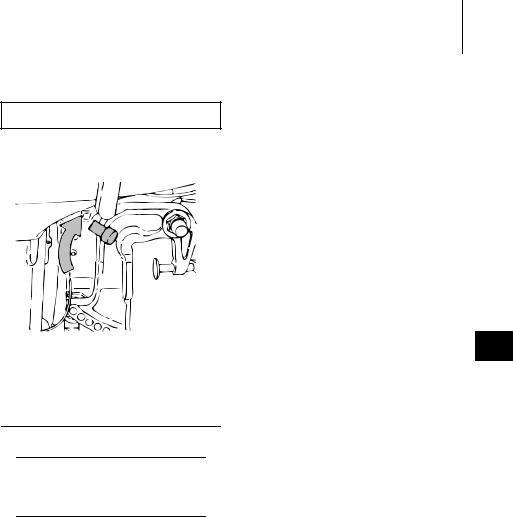
 CAUTION
CAUTION
Before moving the Shift Lever to Reverse, make sure the Reverse Lock is engaged (in up position).
Do not increase the engine speed unnecessarily while reversing.
The Shift Lever cannot be turned from Neutral to Reverse unless the throttle grip has been turned fully toward "SLOW".
Note
Frequent shifting to forward or reverse can accelerate wear or degradation of parts. In such case, replace gear oil earlier than the period specified.
ENGINE OPERATION 25
5

26 ENGINE OPERATION
4. Shallow water running
 WARNING
WARNING
During shallow water operation, be careful not to place your hand between the swivel bracket and the stern bracket.
Be sure to tilt the outboard down slowly.
Note
Slow down to trolling speed, and shift into neutral before setting outboard motor to shallow water drive position.
5 |
WARNING |
|
|
|
Run at lowest possible speed during cruising using shallow water drive.
Tilt lock is disabled when in shallow water drive position.
When driving shallow water, be careful not to strike outboard motor against sea bottom, or propeller may be pushed out of water, resulting in loss of control.
 CAUTION
CAUTION
While in shallow water drive position, do not operate the outboard in reverse. Operate the outboard at slow speed and keep the cooling water intake submerged.
F type
1Set the Reverse Lock Lever provided on the starboard side to "Release" by turning it downward.
Reverse lock lever
2Tilt the engine up approx.
45° and lower it. The engine will now be set to the shallow water setting.
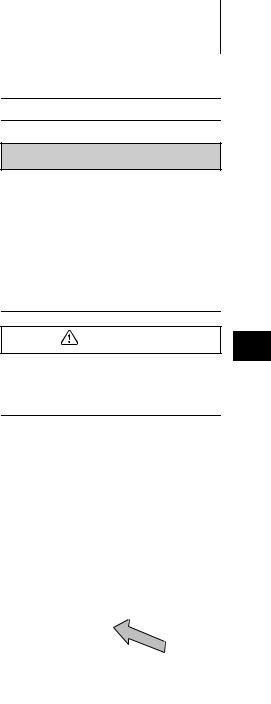
3 Releasing the shallow water setting a.Turn the Reverse Lock Lever upward to
set them in "LOCK" position.
b.Tilt up the engine slightly and then let it go down. The shallow water setting is then released.
c.The engine is released from shallow water setting, and locked at normal running position.
ENGINE OPERATION 27
5. Stopping the engine
 WARNING
WARNING
Do not shift into Reverse during planning, or control will be lost leading to serious personal injury, boat may swamp, and/or hull may be damaged.
Do not shift into Reverse during cruising, or control may be lost, falling down or causing passenger(s) to be thrown overboard. Leading to serious personal injury, and steering system and/or shifting mechanism may be damaged.
CAUTION |
5 |
|
Never stop the engine immediately after a full throttle run. Keep it running for two or three minutes at idling speed (Shift Lever set to Neutral) to allow it to cool down.
F type
1 Reduce the engine speed to idling rpm.
2Keep pressing on the Stop Switch or pull out the lock plate/ The engine will then stop.
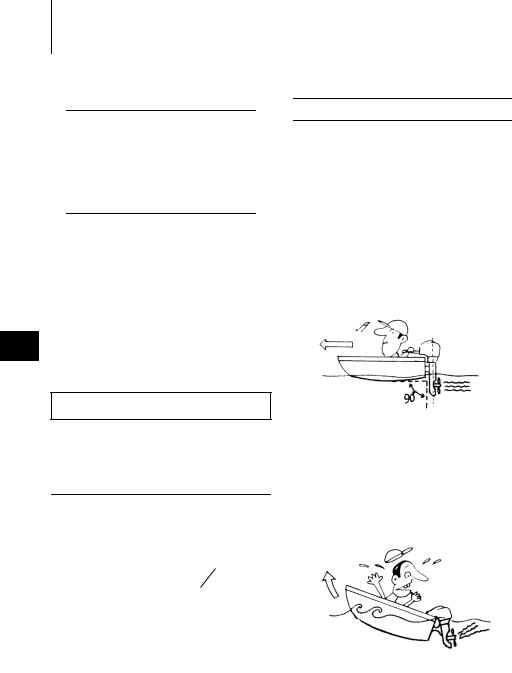
28 ENGINE OPERATION
Notes
After stopping the engine, close the air vent screw on the tank cap.
Disconnect the fuel connector of the engine or the fuel tank.
Disconnect the cables from the battery if the engine will not be used for an extended period of time.
3Disconnect the fuel connector from the engine.
5
 CAUTION
CAUTION
Never fill up portable fuel tanks on board to avoid fire or explosion resulting from spilled gasoline. If gasoline is ever spilled on board, wipe it up thoroughly. Fuel tanks must always be filled up on land.
4Close the air vent screw on the fuel tank cap.
Air vent screw
6. Trim angle
The following instructions explain how to set the best trim angle of the boat.
F type
The trim angle is adjusted by setting the thrust rod in the correct thrust rod hole.
Proper trim angle
The trim angle is optimum when the boat is parallel to the water surface while running.
Perpendicular to the water surface
Improper trim angle (bow rises too high)
If the trim angle is excessive, the bow will rise out of the water and the speed will decrease.
Furthermore, the bow may sway or the bottom may slam the water while cruising.
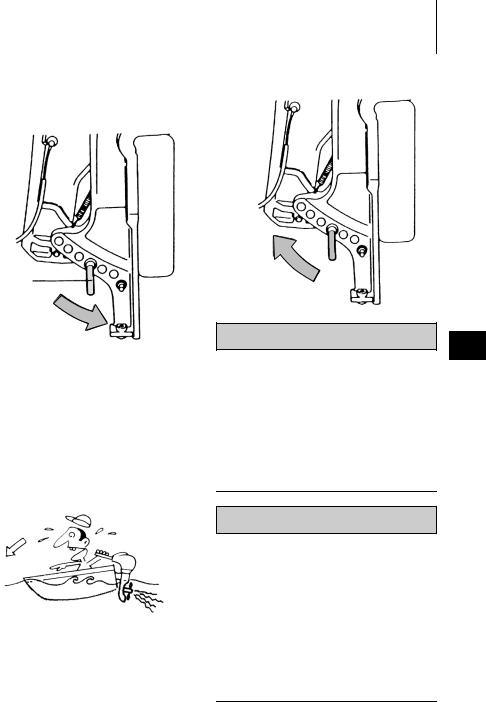
ENGINE OPERATION 29
In this case, decrease the trim angle by setting the thrust rod in a lower hole.
Thrust rod
Select a lower hole
Improper Trim Angle (bow dips into the water)
If the trim angle is too small, the bow will dip into water, the speed will decrease, and water may enter the boat.
In this case, the trim angle should be increased by setting the thrust rod in a higher hole.
Upward
Select a higher hole
 WARNING 5
WARNING 5
Do not put hand or finger in between outboard motor body and clamp bracket when adjusting trim angle to prevent injury in case the outboard motor body falls.
Unsuitable trim position can cause loss of control of boat.
When testing a trim position, run boat slow initially to see if it can be controlled safely.
 WARNING
WARNING
Excessive trim up or down may lead to unstable boat operation, potentially causing the steering difficulty that leads to accident during cruising.
Do not cruise at high speed if improper trim position is suspected. Stop the boat and readjust trim angle before continuing cruise.
For outboard motor model with PTT switch on the bottom cowl, do not operate the switch during cruising, or control of boat may be lost.
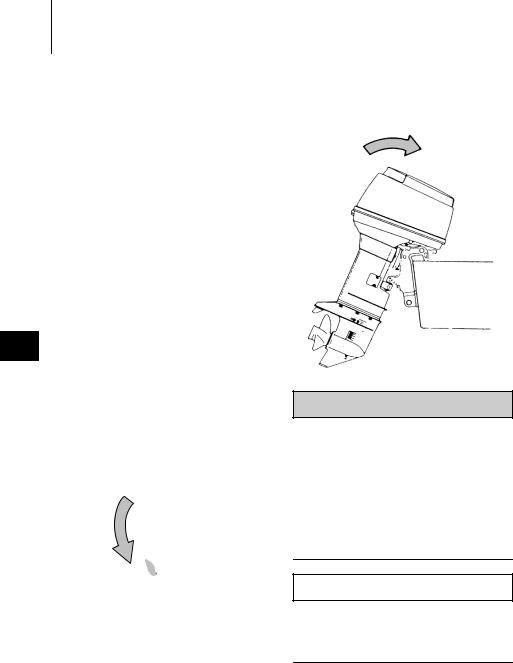
30 ENGINE OPERATION
|
|
3 Tilt the engine up entirely. The tilt will |
|
7. Mooring with the engine tilted up |
|||
lock in the raised position. |
|||
|
|
||
When the engine has been stopped and it |
|
||
will not be used for a long time or when |
|
||
mooring in shallow water, tilt the engine up |
|
||
to prevent damage to the propeller and |
|
||
gear case. |
|
||
1 Disconnect the fuel connector from the |
|
||
engine. |
|
||
5
2Set the Reverse Lock Lever on the starboard side to "RELEASE" by turning it downward.
Reverse lock lever
 WARNING
WARNING
Do not put hand or finger in between outboard motor body and clamp bracket when adjusting trim angle to prevent the body parts from being caught in case the outboard motor body falls.
When tilting up outboard motor with fuel joint for over a few minutes, be sure to disconnect fuel hose or close fuel cock, or fuel may leak, potentially catching fire.
 CAUTION
CAUTION
Do not tilt up outboard motor during operation, or engine may be damaged from overheating because of no feed of cooling water.
